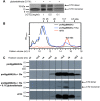The outer-membrane export signal of Porphyromonas gingivalis type IX secretion system (T9SS) is a conserved C-terminal β-sandwich domain
- PMID: 27005013
- PMCID: PMC4804311
- DOI: 10.1038/srep23123
The outer-membrane export signal of Porphyromonas gingivalis type IX secretion system (T9SS) is a conserved C-terminal β-sandwich domain
Abstract
In the recently characterized Type IX Secretion System (T9SS), the conserved C-terminal domain (CTD) in secreted proteins functions as an outer membrane translocation signal for export of virulence factors to the cell surface in the Gram-negative Bacteroidetes phylum. In the periodontal pathogen Porphyromonas gingivalis, the CTD is cleaved off by PorU sortase in a sequence-independent manner, and anionic lipopolysaccharide (A-LPS) is attached to many translocated proteins, thus anchoring them to the bacterial surface. Here, we solved the atomic structure of the CTD of gingipain B (RgpB) from P. gingivalis, alone and together with a preceding immunoglobulin-superfamily domain (IgSF). The CTD was found to possess a typical Ig-like fold encompassing seven antiparallel β-strands organized in two β-sheets, packed into a β-sandwich structure that can spontaneously dimerise through C-terminal strand swapping. Small angle X-ray scattering (SAXS) revealed no fixed orientation of the CTD with respect to the IgSF. By introducing insertion or substitution of residues within the inter-domain linker in the native protein, we were able to show that despite the region being unstructured, it nevertheless is resistant to general proteolysis. These data suggest structural motifs located in the two adjacent Ig-like domains dictate the processing of CTDs by the T9SS secretion pathway.
Figures








Similar articles
-
PorZ, an Essential Component of the Type IX Secretion System of Porphyromonas gingivalis, Delivers Anionic Lipopolysaccharide to the PorU Sortase for Transpeptidase Processing of T9SS Cargo Proteins.mBio. 2021 Feb 23;12(1):e02262-20. doi: 10.1128/mBio.02262-20. mBio. 2021. PMID: 33622730 Free PMC article.
-
Structural and functional insights into the C-terminal signal domain of the Bacteroidetes type-IX secretion system.Open Biol. 2024 Jun;14(6):230448. doi: 10.1098/rsob.230448. Epub 2024 Jun 12. Open Biol. 2024. PMID: 38862016 Free PMC article.
-
PG1058 Is a Novel Multidomain Protein Component of the Bacterial Type IX Secretion System.PLoS One. 2016 Oct 6;11(10):e0164313. doi: 10.1371/journal.pone.0164313. eCollection 2016. PLoS One. 2016. PMID: 27711252 Free PMC article.
-
Type IX secretion: the generation of bacterial cell surface coatings involved in virulence, gliding motility and the degradation of complex biopolymers.Mol Microbiol. 2017 Oct;106(1):35-53. doi: 10.1111/mmi.13752. Epub 2017 Aug 9. Mol Microbiol. 2017. PMID: 28714554 Review.
-
The Type IX Secretion System (T9SS): Highlights and Recent Insights into Its Structure and Function.Front Cell Infect Microbiol. 2017 May 26;7:215. doi: 10.3389/fcimb.2017.00215. eCollection 2017. Front Cell Infect Microbiol. 2017. PMID: 28603700 Free PMC article. Review.
Cited by
-
Genes Contributing to Porphyromonas gingivalis Fitness in Abscess and Epithelial Cell Colonization Environments.Front Cell Infect Microbiol. 2017 Aug 28;7:378. doi: 10.3389/fcimb.2017.00378. eCollection 2017. Front Cell Infect Microbiol. 2017. PMID: 28900609 Free PMC article.
-
Functional study of Bergeyella cardium KP-43 subfamily peptidases as putative T9SS cargo.Commun Biol. 2025 Apr 9;8(1):586. doi: 10.1038/s42003-025-07996-y. Commun Biol. 2025. PMID: 40204855 Free PMC article.
-
Plant-Derived Exosomal Nanoparticles Inhibit Pathogenicity of Porphyromonas gingivalis.iScience. 2019 Nov 22;21:308-327. doi: 10.1016/j.isci.2019.10.032. Epub 2019 Oct 21. iScience. 2019. PMID: 31678913 Free PMC article.
-
Expression of human and Porphyromonas gingivalis glutaminyl cyclases in periodontitis and rheumatoid arthritis-A pilot study.Arch Oral Biol. 2019 Jan;97:223-230. doi: 10.1016/j.archoralbio.2018.10.022. Epub 2018 Oct 28. Arch Oral Biol. 2019. PMID: 30399509 Free PMC article.
-
Structural insights unravel the zymogenic mechanism of the virulence factor gingipain K from Porphyromonas gingivalis, a causative agent of gum disease from the human oral microbiome.J Biol Chem. 2017 Apr 7;292(14):5724-5735. doi: 10.1074/jbc.M117.776724. Epub 2017 Feb 14. J Biol Chem. 2017. PMID: 28196869 Free PMC article.
References
-
- Desvaux M., Hébraud M., Talon R. & Henderson I. R. Outer membrane translocation: numerical protein secretion nomenclature in question in mycobacteria. Trends Microbiol. 17, 338–340 (2009). - PubMed
-
- Fitzpatrick R. E., Wijeyewickrema L. C. & Pike R. N. The gingipains: scissors and glue of the periodontal pathogen, Porphyromonas gingivalis. Future Microbiol. 4, 471–487 (2009). - PubMed
-
- Pavloff N. et al.. Molecular cloning and characterization of Porphyromonas gingivalis lysine-specific gingipain. A new member of an emerging family of pathogenic bacterial cysteine proteinases. J. Biol. Chem. 272, 1595–1600 (1997). - PubMed
Publication types
MeSH terms
Substances
Grants and funding
LinkOut - more resources
Full Text Sources
Other Literature Sources

